Inside The New York Botanical Garden
Posted in Exhibitions, Programs and Events, Science on January 21 2009, by Plant Talk
 |
Nick Leshi is Associate Director of Public Relations and Electronic Media. |
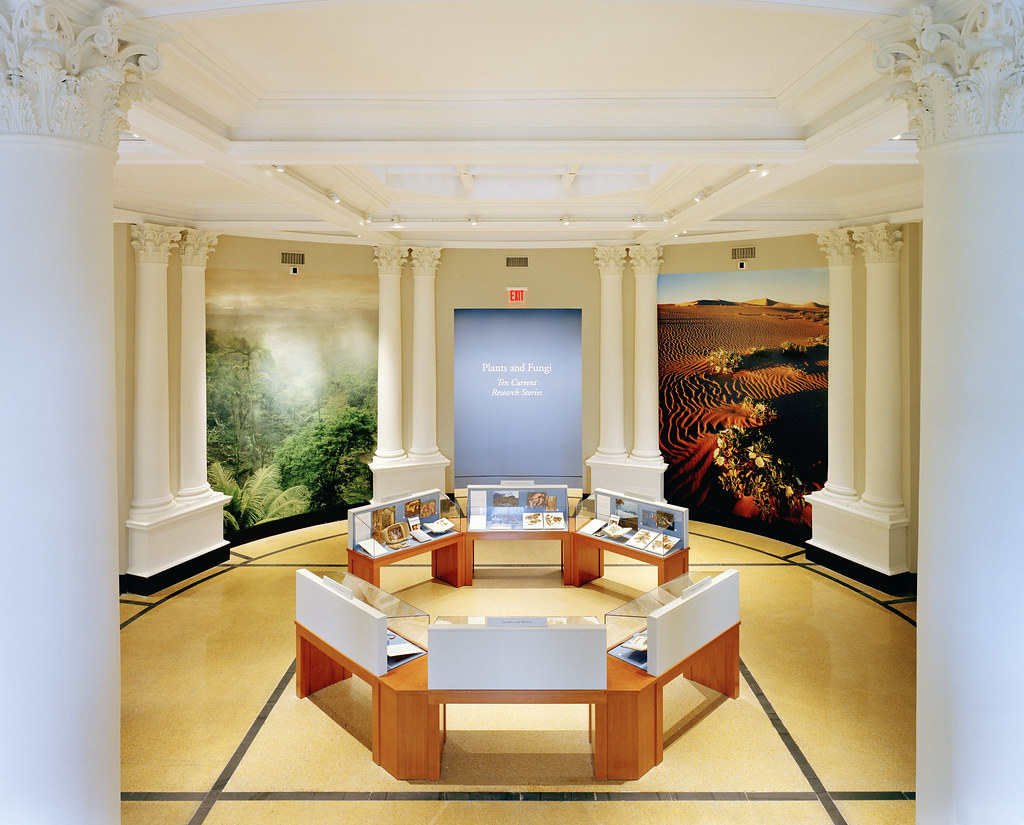 When I talk about The New York Botanical Garden, one phrase I tend to repeat over and over is: “No matter what the weather is like outside, there is always something to see and do here, both indoors and out.” In addition to the beauty of the Garden’s grounds and living collections in every season, there are also great indoor attractions. One of my absolute favorites is located on the fourth floor of the Library building—the permanent exhibition Plants and Fungi: Ten Current Research Stories.
When I talk about The New York Botanical Garden, one phrase I tend to repeat over and over is: “No matter what the weather is like outside, there is always something to see and do here, both indoors and out.” In addition to the beauty of the Garden’s grounds and living collections in every season, there are also great indoor attractions. One of my absolute favorites is located on the fourth floor of the Library building—the permanent exhibition Plants and Fungi: Ten Current Research Stories.
The exhibition, housed in the grand Britton Science Rotunda and Gallery, allows visitors to explore the important research being conducted by Botanical Garden scientists here in the Bronx and around the world. Massive mural images of the Garden’s founders, Nathaniel Lord Britton and Elizabeth Knight Britton, overlook a map showing the corners of the world where our scientists have traveled for field research to solve some the mysteries of nature and to better understand the role of plants and fungi in our lives, part of the Garden’s overall mission as an advocate for the plant kingdom.
 The rotunda features multiple displays illustrating the “William C. Steere Tradition,” with information on mosses, lichen, and three panels on mushrooms and berries. It educates the public on the legacy and influence of the man for whom the adjacent William and Lynda Steere Herbarium is named and where over 7 million plant and fungi specimens are archived. Computer terminals in the Gallery allow visitors to access the online specimen catalog from the C.V. Starr Virtual Herbarium.
The rotunda features multiple displays illustrating the “William C. Steere Tradition,” with information on mosses, lichen, and three panels on mushrooms and berries. It educates the public on the legacy and influence of the man for whom the adjacent William and Lynda Steere Herbarium is named and where over 7 million plant and fungi specimens are archived. Computer terminals in the Gallery allow visitors to access the online specimen catalog from the C.V. Starr Virtual Herbarium.
Other computer stations in the exhibition provide audio-video presentations explaining Garden scientists’ research on rice, cycads, brazil nuts, squashes, ferns, and vanilla orchids. Visitors young and old can see how modern tools such as DNA fingerprinting as well as classic techniques of plant exploration are used, and how scientists are studying vital topics like genetic diversity in rice and a nerve toxin in cycads that may provide insight into neurological diseases.
You can meet some of the scientists in person and hear them discuss their research as part of the 2009 Gallery Talks series Around the World with Garden Scientists in the Britton Science Rotunda and Gallery. Robbin Moran, Ph.D., kicks off the series this Saturday, January 24, at 1 p.m. with his presentation “The Fascinating World of Ferns” and provides a behind-the-scenes tour of the Herbarium.
Posted in Gardening Tips on January 20 2009, by Sonia Uyterhoeven
Easy Design Steps for the Home Gardener
 Sonia Uyterhoeven is Gardener for Public Education at The New York Botanical Garden.
Sonia Uyterhoeven is Gardener for Public Education at The New York Botanical Garden.
 A few years ago I designed a French kitchen garden (potagér). I was under a time constraint to come up with ideas, so I fell back on some good advice that I was given at the beginning of my career. “Why do things on your own when you can always solicit the help of others?” In terms of design, the easiest way to do this is to make use of a good library. Books are full of good ideas that can be borrowed and transposed into your own creations.
A few years ago I designed a French kitchen garden (potagér). I was under a time constraint to come up with ideas, so I fell back on some good advice that I was given at the beginning of my career. “Why do things on your own when you can always solicit the help of others?” In terms of design, the easiest way to do this is to make use of a good library. Books are full of good ideas that can be borrowed and transposed into your own creations.
My initial task was to construct a framework for the garden. Raised beds provided a structure for much of the garden, but an extensive open area was up for grabs. Did I want an orderly, linear display in this area or flowing swaths of texture and color comprised of a conglomerate of herbs, flowers and vegetables?
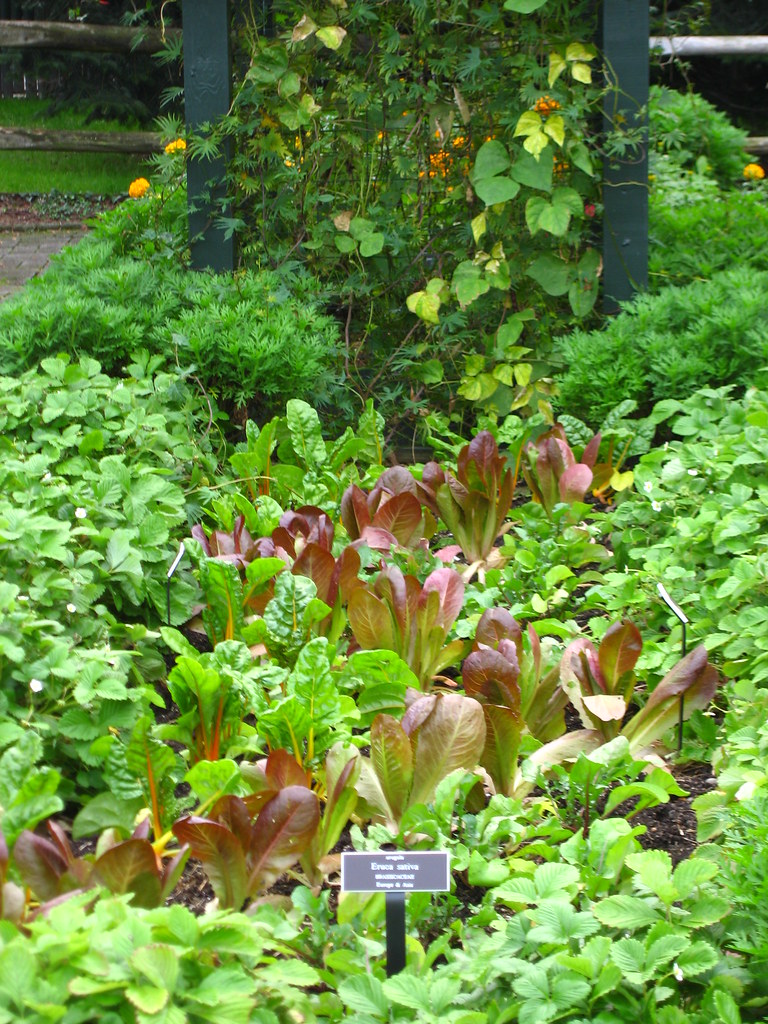 The answer was my typical “Let’s try a little of everything.” I found a wonderful illustration of a kitchen garden that contained tidy, linear rows that were separated in the middle with a bountiful oasis of flowers and herbs.
The answer was my typical “Let’s try a little of everything.” I found a wonderful illustration of a kitchen garden that contained tidy, linear rows that were separated in the middle with a bountiful oasis of flowers and herbs.
In the illustration an espalier of apples lined the sides of the middle expanse and acted as a transition from the linear vegetable rows to the free-flowing flowers. In my design I replaced the espaliers of apples with an espalier of tomatoes. This idea came from another book that described unusual ways to stake your tomatoes.
Once I had decided on the overall structure, the rest of the design quickly fell into place. Vegetables filled the raised beds, herbs and flowers spilled over the edges. Cute little ‘Tumbling Tom’ tomatoes spilled over the side of one bed lined by colorful ornamental peppers. With the structure in place, it was now a matter of selecting my choices from a myriad of vegetables and herbs.
Attention was paid to companion planting—potatoes joined peas in one bed, nasturtiums frolicked with tomatoes in another and rue snuggled up to a fig. Containers of sweet peas were supported by homemade teepees made from bamboo stakes. Marigolds skirted the sides in a hopeful attempt to ward off aphids.
Designing gardens, whether for vegetables or flowers, can be fun and easy. Borrowing ideas from other sources is a great way to start. Begin the process by staging your garden scene with a structure or a framework. Then carefully plug in the plants and any decorative elements.
Designs work best when you work with different layers—different heights, different shapes, different textures. To ensure that you do not end up with a cacophony of colors and textures, remember to apply the design principles of unity and repetition. A good design should form a coherent whole. Repetition of color, shapes, and textures are an easy way of creating a sense of continuity.
Winter is a wonderful time to sit down with design books and catalogs to start planning the gardening year ahead. Have fun.
Posted in Exhibitions, Programs and Events on January 16 2009, by Plant Talk
The Legacy of George Washington Carver
 |
Dachell McSween is Publicity Coordinator at The New York Botanical Garden. |
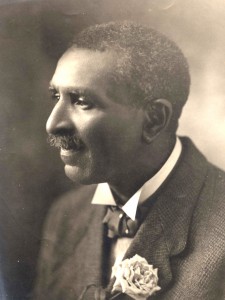
One of my favorite times in the Garden is in January. Yes, I know it is cold outside and it gets dark early, but I look forward to seeing The Life and Work of George Washington Carver exhibit and program in the Everett Children’s Adventure Garden. This fun and informative exhibit looks at the life of George Washington Carver, the renowned plant scientist who created hundreds of uses for peanuts, soybeans, and sweet potatoes.
Dr. Carver was born to slave parents in Diamond Grove, Missouri, in 1864. As a child, he developed an early interest in plants. In fact, he became known as the “plant doctor” for helping neighbors and friends with ailing plants. He learned to read, write, and spell at home, because there were no schools for blacks in his hometown. In 1891 he became the first black person to enroll at Iowa State College of Agriculture and Mechanic Arts, known today as Iowa State University. After completing his Bachelor’s Degree in 1894, Dr. Carver’s professors encouraged him to stay on as a graduate student. He became known for his excellence in plant breeding and was appointed to Iowa State’s faculty, becoming its first black faculty member.
The exhibit in the Children’s Adventure Garden makes me appreciate all of Dr. Carver’s vast accomplishments. I enjoy seeing children transform into “plant scientists” by putting on lab coats and picking up a magnifying glass to diagnose and remedy sick plants, just like Dr. Carver did as a child. The children also create a personal science timeline, plant a soybean to take home, and enjoy stepping into the interactive yellow replica of Dr. Carver’s Jesup wagon, which he used as a traveling school to help spread his agricultural knowledge to farmers and homemakers. The wagon was named after Morris K. Jesup, a New York financier and philanthropist.
As we look forward to celebrating Dr. Martin Luther King Jr. Day and the inauguration of America’s first black president, it is inspiring to see children get excited about this remarkable program that encourages them not only to learn about plant science, but also to dream big and impact the world, just like Dr. Carver did.
Check out Saturday’s programming
Check out Sunday’s programming
Posted in Gardens and Collections on January 15 2009, by Sonia Uyterhoeven
 |
The Botanical Garden’s living collections is among the greatest in the world and contains more than 1 million plants. Jon Peter, Plant Records Manager, periodically shines the spotlight on a particular species that can be found within our 250 acres.
|

Botanical Name: Ilex verticillata
Common Name(s): Winterberry
Family Name: Aquifoliaceae (Holly family)
Native Range: USA—Maine to Florida, west to Minnesota and Texas
Canada—Newfoundland to Ontario
USDA Hardiness Zones: 3 through 9
Location(s) within NYBG: Native Plant Garden, Everett Children’s Adventure Garden, Home Gardening Center
Site Requirements: Sun to partial shade; well-drained, moist, organic soil; can tolerate extended periods of flooding
Interesting Note: This native species is one of a small number of hollies that are deciduous, losing their leaves in the autumn to reveal the orange to red berries that persist into winter. The berries become an important food source for birds when other sources diminish. Like all hollies, this species is dioecious, meaning it has separate male and female plants and both need to be present for pollination of flowers and subsequent production of fruit.
In a previous video entry, The Garden’s own Sonia Uyterhoeven talked about winterberry and other types of plants that provide beauty and food for wildlife.
Editor’s note: Though winter is not even a month old, birds have already eaten all the fruit from the Garden’s winterberry shrubs.
Posted in Gardens and Collections on January 14 2009, by Plant Talk
 Carol Capobianco is Editorial Content Manager at The New York Botanical Garden.
Carol Capobianco is Editorial Content Manager at The New York Botanical Garden.
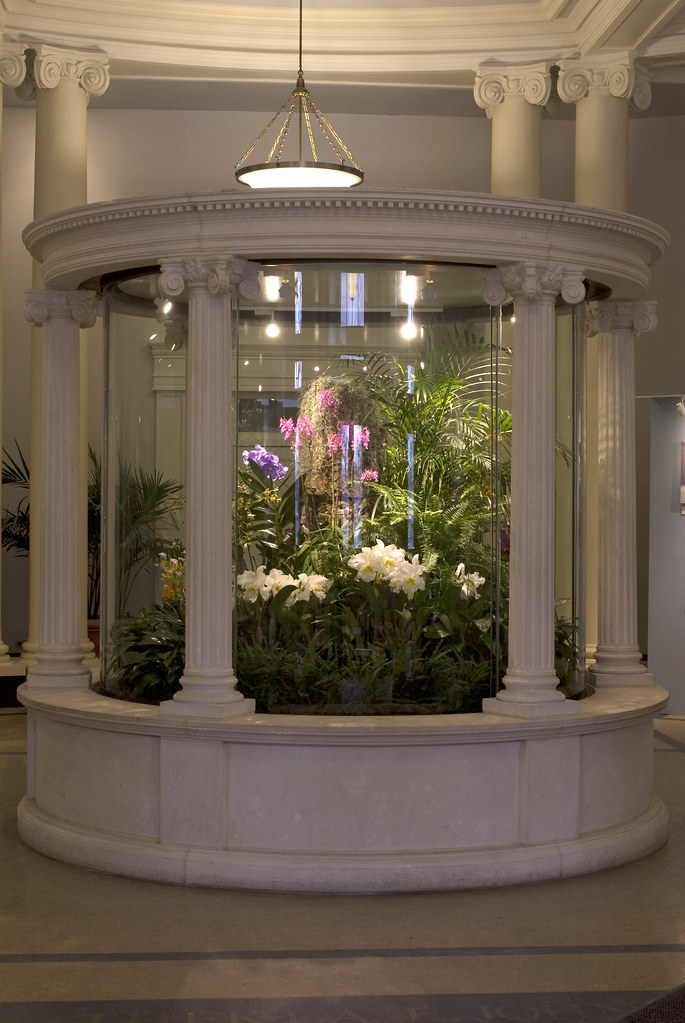 What a glorious sight to come upon: the beautiful orchids displayed in the Orchid Rotunda on the second floor of the Library Building. Brilliant hues, fantastic shapes, lovely arrangements.
What a glorious sight to come upon: the beautiful orchids displayed in the Orchid Rotunda on the second floor of the Library Building. Brilliant hues, fantastic shapes, lovely arrangements.
The continuous show of these colorful gems that brighten any gloomy day had been on hiatus since mid-April of 2008, when the display case was installed with the maquettes and found objects of sculptor Henry Moore in conjunction with the Moore in America exhibition across the Garden grounds.
Though Moore in America has been extended to March 15, the artist’s scale models, tools, and collection of bones, rocks, and other natural bits and pieces have been removed to make room, once again, for the spectacular, delicate orchids. And just in time. These magical flowers whet our appetite daily for the upcoming annual Orchid Show, which opens February 28 in the Enid A. Haupt Conservatory.
In the meantime, on a cold, gray day—or any day—come marvel at this display, which is refreshed twice a week. It is sure to lift your spirits.
Posted in Learning Experiences on January 13 2009, by Plant Talk
 |
Joan McGillicuddy, a double certificate graduate of the Continuing Education program, now has her own design company, The Surrogate Gardener, on Long Island.
|
It’s a new year, so it is time for me to see which lectures in the American Gardening Lecture Series I might be able to schedule. I started attending NYBG’s Lecture Series years ago as part of a personal goal to expand my plant knowledge. I went on to complete two certificates, one in Horticulture and one in Landscape Design, through the Botanical Garden’s Continuing Education program and now have a career as a landscape designer. Yet, every year I still make time to attend several of the lectures in this series. I am an unrepentant plantaholic. In spite of what some garden design books say about having a plan, several past presenters have admitted to the same compulsions, so I merrily continue to experiment with new plants.
It doesn’t matter how many garden books or magazines I read, there is nothing like the immediacy of listening in person to experts— landscape architects and designers, plant hybridizers and nurserymen, authors and garden curators—impart their knowledge. The Lecture Series always offers a diverse mix of subjects and speakers, and I always leave inspired to try new plant introductions, new combinations of tried and true plants, or new horticultural practices. Then there is the added treat of reviewing the books laid out like jewels on the tables in the Gallery outside the Lecture Hall, which only tempts me to go to the Shop to review the entire book collection.
The Lecture Series is scheduled at a perfect time of the year, when my garden is quiet and nursery catalogs are arriving and I have time to track down the plants I am inspired to try. After the lectures and a bowl of soup at the Cafe, I stroll through NYBG’s gardens and see which plants are greeting the new year, since it is warmer here than at my home on Long Island. My favorite plant is the large Hamamelis on the outer drive that holds its yellow flowers through the snow. It always signals to me that spring is around the corner. The Ladies’ Border, which runs along the south side of the Conservatory, always has something new in bloom each month of the series, whether it is January, February, or March. It might be Mahonia, Edgeworthia, Hamamelis, Helleborus, or Camellia. This year it will be a treat to watch the emergence of the display beds across from the Cafe entrance, known as Seasonal Walk, that were created by the well-known designers Piet Oudolf and Jacqueline van der Kloet. I happened to see the beds being installed this past fall, and they look to be an intriguing mix of bulbs, perennials, and grasses.
At a time when much of the world news is gloomy, it is nice to have all this to look forward to.
Posted in Gardening Tips on January 12 2009, by Sonia Uyterhoeven
Winter Wonderland
 Sonia Uyterhoeven is Gardener for Public Education at The New York Botanical Garden.
Sonia Uyterhoeven is Gardener for Public Education at The New York Botanical Garden.
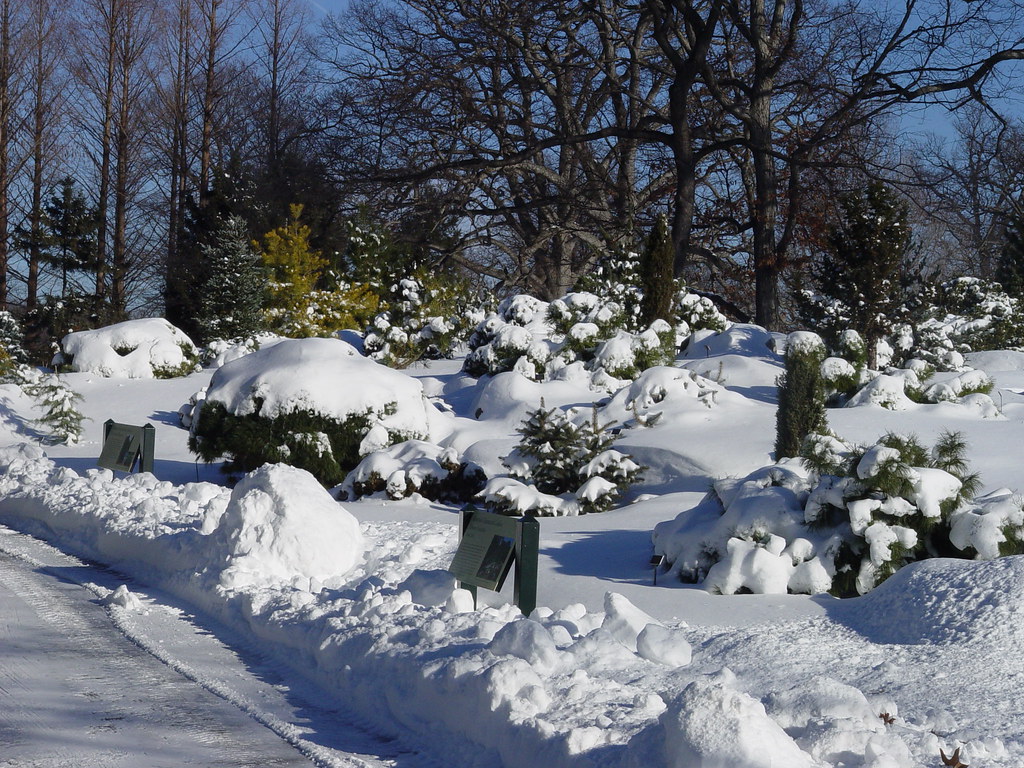 The Garden looks like a winter wonderland when it snows. The quiet and calm of the white landscape is deceptive. The aftermath of a storm causes us to scurry around shaking the snow off hedges and prized evergreen shrubs as well as clearing paths and benches.
The Garden looks like a winter wonderland when it snows. The quiet and calm of the white landscape is deceptive. The aftermath of a storm causes us to scurry around shaking the snow off hedges and prized evergreen shrubs as well as clearing paths and benches.
The yew hedge that delineates the perennial garden struggles under the weight of wet snow. Brooms and rakes (not shovels) are used to gently remove the snow. The snow blowers are instructed to point their machines away from the hedge to minimize unnecessary damage. When removing snow in your own home gardens, push upward with the broom rather than downward to minimize pressure. Remember not to use hedges and foundation borders as dump sites for excess snow.
Snow acts as an excellent insulator during the cold winter months. Small plants can remain covered, but larger or more fragile plants need to be shaken off to ensure that their branches are not disfigured or broken by the weight of the snow.
If you have a narrow, upright conifer (such as an arborvitae) that you are worried will lose its shape, tie susceptible branches with nylon tree ties or arbor ties that you can purchase at a garden center. If you are curious to see how this is done, come and inspect the small arborvitae located at the Fountain of Life in front of the library building. We carefully tie these trees in November. An alternative solution is to place a stake at the back of the tree and loosely wrap garden twine around the tree and stake starting at the bottom and moving upward. This can also be done without a stake by simply attaching the twine to the trunk of the tree and winding the twine around the branches.
These simple yet important steps are taken to ensure that the landscape of the Garden is not only beautiful but also well maintained throughout the winter and into the spring. They are easy for you to do in your own home gardens.
Posted in Holiday Train Show, Kiku, Moore in America on January 9 2009, by Plant Talk
Holiday Train Show and Japanese Art Exhibit Take a Bow
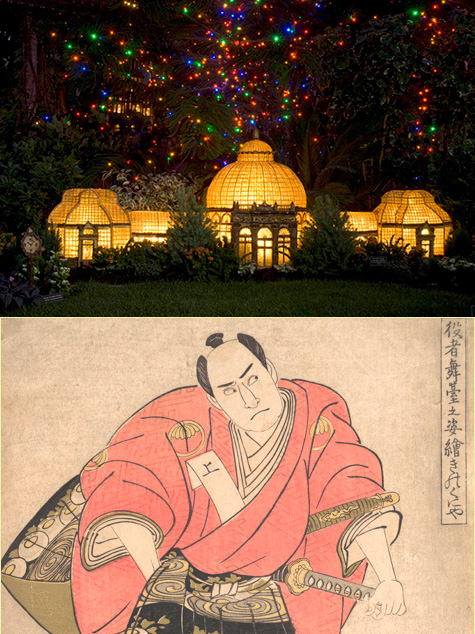 Another exhibition season ends this weekend with the closing of the ever-popular Holiday Train Show as well as the stunning exhibition The Chrysanthemum in Japanese Art.
Another exhibition season ends this weekend with the closing of the ever-popular Holiday Train Show as well as the stunning exhibition The Chrysanthemum in Japanese Art.
In fact, you have the value-added opportunity to see four remarkable exhibitions for the price of one All-Garden Pass admission ticket. In addition to these two shows, you can also see Moore in America, which has been extended to March 15, and The Heirloom Tomato: An Exhibition of Photographs by Victor Schrager.
What a deal—especially in these financially challenging times.
Posted in Exhibitions, Moore in America, NYBG in the News on January 8 2009, by Plant Talk
 |
Nick Leshi is Associate Director of Public Relations and Electronic Media. |
Visitors of all ages have marveled at the sight of the monumental sculpture throughout the grounds of The New York Botanical Garden, where these works of art have stood sentinel since last spring. Moore in America, the largest exhibition of Henry Moore’s art ever displayed in a single venue in the United States, continues to attract praise from audiences and journalists alike, including Time magazine’s art critic Richard Lacayo, who named it one of the Top 10 Museum Exhibits of 2008.
Photographers, in particular, have been drawn to Moore’s captivating forms situated within the Garden’s historic landscape. In partnership with the International Center of Photography, the Botanical Garden hosted a photography contest in celebration of the landmark exhibition. The contest sparked many beautiful submissions, from which four monthly finalists were selected. From those four a grand prize was awarded, to Jimin Kim of Manhattan for his portrait of Large Reclining Figure. His winning image appeared in an advertisement for Moore in America in the December 4–10 issue of Time Out New York.
Runners-up included Julie Salles of Yonkers, Ken Schwarzof Lexington, Massachusetts, and Debra Allen of Pelham Manor. Their images, plus countless others submitted by garden- and art-loving shutterbugs during the months of the competition, showed how the sculpture could look fresh from different angles and with different lighting throughout the day and during the changing seasons, proving Moore’s desire to have viewers approach—and even touch—his artwork from different perspectives.
If you haven’t seen the exhibition yet, now is your chance. Moore in America is being extended through March 15. Even if you’ve seen it in spring, summer, or fall, now is your opportunity to see it in winter. Bring your camera and snap some pics for yourself while you’re at it!
Posted in Programs and Events on January 7 2009, by Plant Talk
 |
Samantha Buck is an Interpretation Intern for Public Education. |
 On my second day as an intern with The New York Botanical Garden, I had the esteemed pleasure of meeting Sir Topham Hatt and Thomas the Tank Engine™ from the Island of Sodor (both of whom were much larger than I remembered from watching the television show as a child). The excitement was palpable as a growing number of fans arrived in the Arthur and Janet Ross Lecture Hall, the majority of whom toted small children anxious for the experience.
On my second day as an intern with The New York Botanical Garden, I had the esteemed pleasure of meeting Sir Topham Hatt and Thomas the Tank Engine™ from the Island of Sodor (both of whom were much larger than I remembered from watching the television show as a child). The excitement was palpable as a growing number of fans arrived in the Arthur and Janet Ross Lecture Hall, the majority of whom toted small children anxious for the experience.
I carefully folded the gray and white paper conductor’s hat that was presented to me, pulled the elastic around my head, and was ready for my adventure! As I was greeted by the silently enthusiastic Sir Topham Hatt, visitors settled in to watch an episode or two of Thomas & Friends, who came to life on the big screen. Following the film, some in the audience went forward to meet Sir Topham Hatt. It was refreshing to see the youngsters interacting with him so animatedly.
I got the royal treatment: becoming an honorary engineer so I could “help Thomas and his friends out if they were ever in trouble.” Younger “engineers” were also presented with coloring pages of Thomas, James, Percy, and Gordon, along with a box of crayons and stickers depicting other favorites. And of course, no visit to this event would be complete without a photo with Thomas the Tank Engine™ himself, happy and eager as ever to meet each and every one of his fans.
Come visit Thomas the Tank Engine™—he’s here through January 11.

 When I talk about The New York Botanical Garden, one phrase I tend to repeat over and over is: “No matter what the weather is like outside, there is always something to see and do here, both indoors and out.” In addition to the beauty of the Garden’s grounds and living collections in every season, there are also great indoor attractions. One of my absolute favorites is located on the fourth floor of the Library building—the permanent exhibition Plants and Fungi: Ten Current Research Stories.
When I talk about The New York Botanical Garden, one phrase I tend to repeat over and over is: “No matter what the weather is like outside, there is always something to see and do here, both indoors and out.” In addition to the beauty of the Garden’s grounds and living collections in every season, there are also great indoor attractions. One of my absolute favorites is located on the fourth floor of the Library building—the permanent exhibition Plants and Fungi: Ten Current Research Stories. The rotunda features multiple displays illustrating the “William C. Steere Tradition,” with information on mosses, lichen, and three panels on mushrooms and berries. It educates the public on the legacy and influence of the man for whom the adjacent William and Lynda Steere Herbarium is named and where over 7 million plant and fungi specimens are archived. Computer terminals in the Gallery allow visitors to access the online specimen catalog from the C.V. Starr Virtual Herbarium.
The rotunda features multiple displays illustrating the “William C. Steere Tradition,” with information on mosses, lichen, and three panels on mushrooms and berries. It educates the public on the legacy and influence of the man for whom the adjacent William and Lynda Steere Herbarium is named and where over 7 million plant and fungi specimens are archived. Computer terminals in the Gallery allow visitors to access the online specimen catalog from the C.V. Starr Virtual Herbarium.











 Another exhibition season ends this weekend with the closing of the ever-popular
Another exhibition season ends this weekend with the closing of the ever-popular 
 On my second day as an intern with The New York Botanical Garden, I had the esteemed pleasure of meeting Sir Topham Hatt and Thomas the Tank Engine™ from the Island of Sodor (both of whom were much larger than I remembered from watching the television show as a child). The excitement was palpable as a growing number of fans arrived in the Arthur and Janet Ross Lecture Hall, the majority of whom toted small children anxious for the experience.
On my second day as an intern with The New York Botanical Garden, I had the esteemed pleasure of meeting Sir Topham Hatt and Thomas the Tank Engine™ from the Island of Sodor (both of whom were much larger than I remembered from watching the television show as a child). The excitement was palpable as a growing number of fans arrived in the Arthur and Janet Ross Lecture Hall, the majority of whom toted small children anxious for the experience.